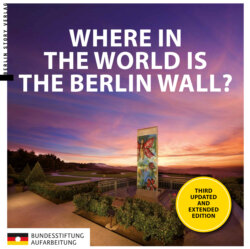Читать книгу Where in the World is the Berlin Wall? - Группа авторов - Страница 16
PGRADING AND PERFECTING THE BORDER INSTALLATIONS 38
ОглавлениеUntil the mid-1960s, the inner-city Wall was built using concrete blocks and barbed wire. In the areas between West Berlin and the surrounding land, metal fencing was put up in place of the Wall. As time went on, a border strip was gradually introduced – it was introduced according to locality and the extent to which the GDR could monitor the area. The border strip was complemented by two, sometimes three, rows of barbed wire fencing, anti-tank barriers, trip wires, dogs on cable-runs and watch towers. In June 1963, a border area (at some points stretching hundreds of metres) was set up. Residents and visitors to this area were only allowed to pass with special permits. This began at the so-called “Hinterlandmauer” (interior wall), which bordered the death strip to the east and formed the actual border for GDR citizens.
Upgrading the Wall followed in the mid-1960s and was carried out according to detailed plans by the military. After the first and second generations of Wall, the third generation followed. The third generation Wall was made up of slabs of concrete and was 3.4-metres-high. “Grenzmauer 75” (Border Wall 75) followed in the mid-1970s. It was an L-shaped Wall made from steel reinforced concrete and was 3.6-metres-long. This type of Wall had been tested for its stability and insurmountability and served as the primary border installation facing the West.
Diagram showing the border fortifications
© BArch DVW 32 (Kommando der Grenztruppen)/112249, pag. 205.
The death strip was 15 to 150-metres-wide and was made up of varying security systems to prevent escape. It was built up from East to West until the end of the 1980s as follows: not far from the East facing “Hinterlandmauer” was a signal fence made up of many electrical wires. If it was touched, an alarm went off. At some points, the fence went half a metre into the ground to prevent people from crawling underneath it. It was lined with floodlights which lit up the death strip and a sand path that went right to the Wall itself. In this way, visibility was always good and the field of fire always visible. Immediately in front of the Wall was the motor vehicle barrier ditch, which was sloped and secured with concrete slabs in such a way that a vehicle would already be halted here. If it did reach the Wall, it would hit the concrete base of the Wall and stabilize it with its own weight. Along the top of the Wall itself was a round pipe which prevented people getting any kind of grip with their hands if they attempted to climb over. At certain weaker points along the border, guard dogs were also put on patrol. The dogs were tied to a wire which ran parallel to the signal fence and could move up and down the length of the wire.
View of the death strip between East and West Berlin 1981
© Archiv Bundesstiftung Aufarbeitung / Bestand Michael von Aichberger Nr. 698
In 1989, the border around West Berlin was a total of 156.4-kilometre-long, of which 43.7 kilometres ran between the two halves of the city and 112 kilometres between West Berlin and the Potsdam district. According to an inventory of the border troops, the border section consisted of 63 kilometres of built-up area, 32 kilometres of wooded area, 22.65 kilometres of open terrain, and 37 kilometres of water border. Along 41.91 kilometres of the border there was the “Grenzmauer 75”, another 58.95 kilometres consisted of the third-generation Wall in prefabricated construction and 68.42 kilometres were bordered by expanded metal fence. The light strip had a length of 161 kilometres and the signal fence covered 113.85 kilometres. There were 186 observation towers and 31 command posts of the border troops in the death strip. Access to West Berlin was possible via 13 road border crossings, four rail border crossings and eight waterway border crossings, all of which were well secured.39
